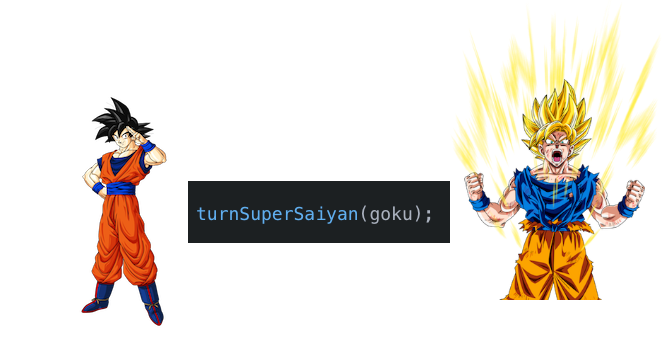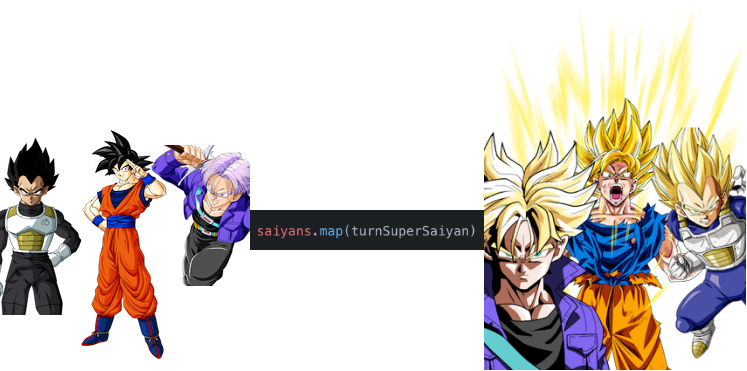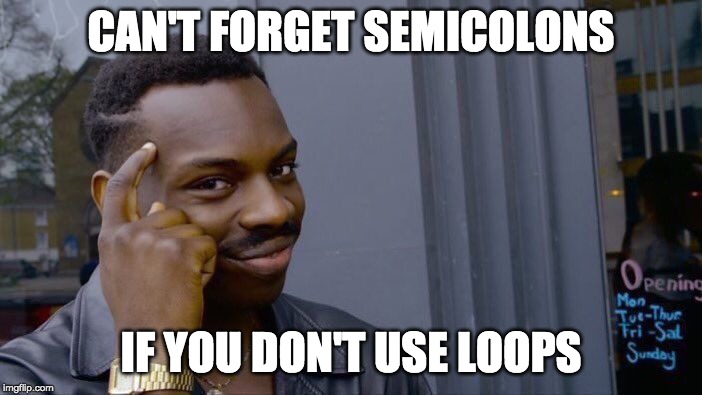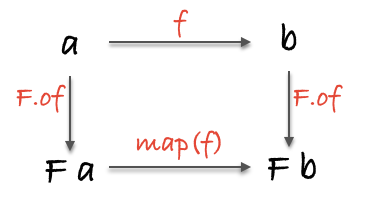Array.map might be JavaScript’s most useful function. Forgoing it nowadays is like donning your toolbelt without a hammer.
To further appreciate map and deepen our understanding of it, let’s see 4 levels of explanations in ascending complexity.
Tell me which ones you got and which ones surprised you!
Table of Contents
To a Five Year Old
Do you know DragonBall Z? Here are my favorite characters from the show!
Goku

Vegeta

Trunks

They’re saiyans, and they’re really strong!
I put them in this list–JavaScript calls them arrays. It lets you hold a bunch of things together:
saiyans = [goku, vegeta, trunks];And I have code that turns them into Super Saiyans, so they get 50x stronger (literally)! This code is called a function.
turnSuperSaiyan = () => {
/* use your imagination */
};
turnSuperSaiyan(goku);
What if I want to transform all 3 of them? I have to run the function 3 times! Repeating things like that is boring 😞
turnSuperSaiyan(goku);
turnSuperSaiyan(vegeta);
turnSuperSaiyan(trunks);Luckily, programming lets you repeat things lots of times really easily! Array.map can turn them all into Super Saiyans at once!
Just plug turnSuperSaiyan in there and get back a new array of Super Saiyan Goku, Vegeta, and Trunks.
superSaiyans = saiyans.map(turnSuperSaiyan);
To a High School Coding Student
Hi!
So you’ve learned for loops. They’re great for performing repetitive work, but I personally haven’t needed one in years.
Don’t get me wrong, I still love automating repetitive work. In fact, most applications involve repetitive work.
Think of these examples…
- Google search results
- Emails
- Contacts
- Text messages
If you boil them down to the core, these everyday apps are just fancy lists. Much of Front-End development is transforming these lists into something user-friendly.
Of course the big picture is more complex, but the core of most apps is manipulating lists!
In a JavaScript program, we represent lists as arrays.
All arrays carry a special method called map. It lets you transform an array into a new one based on some function you give it.
Here’s some numbers.
numbers = [1, 2, 3, 4, 5];And a double function.
double = (x) => x * 2;Can you double each one using a for loop?
doubledNumbers = [];
for (let i = 0; i < numbers.length; i++) {
doubledNumbers.push(double(numbers[i]));
}
// [2, 4, 6, 8, 10]Cool! Here’s the same idea expressed with map.
doubledNumbers = numbers.map(double);
// [2, 4, 6, 8, 10]map constructs the loop under the hood, so you don’t have to worry about typos or missing semicolons anymore!

And this goes beyond just numbers. Here’s some users…
users = [
{
name: 'Bruce Wayne',
location: 'Gotham City',
heroName: 'Batman'
},
{
name: 'Barry Allen',
location: 'Central City',
heroName: 'The Flash'
},
{
name: 'Clark Kent',
location: 'Kryptonopolis',
heroName: 'Superman'
}
];How would you create a new array of every user’s name and heroName? Probably using a for loop.
userInfo = [];
for (let i = 0; i < users.length; i++) {
userInfo.push({
name: users[i].name,
heroName: users[i].heroName
});
}
// Result
[
{
name: 'Bruce Wayne',
heroName: 'Batman'
},
{
name: 'Barry Allen',
heroName: 'The Flash'
},
{
name: 'Clark Kent',
heroName: 'Superman'
}
];Here’s a loop-less version.
userInfo = users.map((u) => ({
name: u.name,
heroName: u.heroName
}));
// Result
[
{
name: 'Bruce Wayne',
heroName: 'Batman'
},
{
name: 'Barry Allen',
heroName: 'The Flash'
},
{
name: 'Clark Kent',
heroName: 'Superman'
}
];See how much easier that is? We can implement map like so:
map = (fn, array) => {
const results = [];
for (let i = 0; i < array.length; i++) {
results.push(fn(array[i]));
}
return results;
};So for every element, call the given function and store it inside a new array!
To a React Developer
Hi!
The Array prototype offers a method called map.
It will loop over your array, calling a given function on each item, and return a new array with those changes.
Instead of a for loop, just use map to get usernames and render the UI.
const App = (users) => {
return (
<ul>
<li>My name is {users.map((u) => u.name)}!</li>
</ul>
);
};Yep you can method chain, since it returns the same type!
const App = (users) => {
return (
<ul>
{users
.map((u) => u.name)
.map((name) => (
<li>My name is {name}!</li>
))}
</ul>
);
};Tremendously useful. Most of your main components will probably use map.
To a Functional Programmer
Map simply lifts a function a -> b into a context F a -> F b.

JavaScript doesn’t extend this expressibility beyond arrays, unfortunately…

Thank you Brian Lonsdorf for the wicked explanation!
And please let me know what else you’d like to see! My DMs are open for questions, comments, and suggestions!